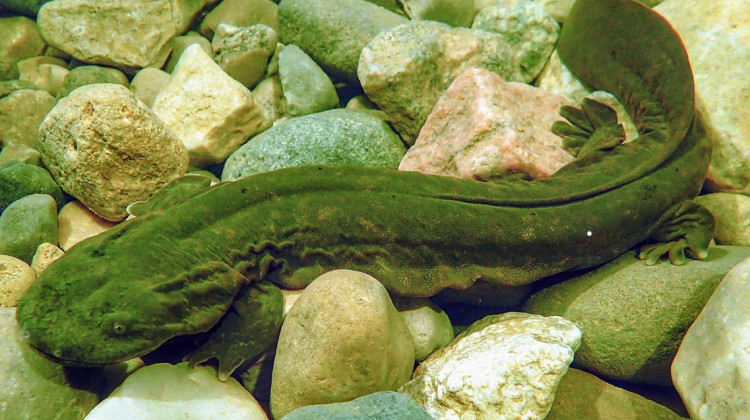
For the first time in decades, biologists with the Indiana Department of Natural Resources have spotted a young hellbender along southern Indiana’s Blue River.
FILE PHOTO: An adult Eastern hellbender salamander. Courtesy of the Williams Lab/Purdue University Department of Forestry and Natural ResourcesFor the first time in decades, biologists with the Indiana Department of Natural Resources have spotted a young hellbender along southern Indiana’s Blue River.
The discovery is good news for the giant aquatic salamander, whose populations have been under threat.
Experts say hellbender populations are state-endangered and their populations have been declining since at least the mid-1900s, mostly due to habitat loss and poor water quality.
Nathan Engbrecht is a herpetologist with the DNR and studies reptiles and amphibians. Some advocates are breeding hellbenders in captivity. He said finding a young hellbender in the wild is a big deal.
“For us that says not only are they mating, not only are they laying eggs, but these things are hatching and we’ve got one -- at least one individual – that has survived until probably about eight months,” he said.
Engbrecht said the sighting is the first time a young hellbender has been spotted in the wild since the 1980s. Hellbenders don’t reach sexual maturity until they are roughly 7 to 8 years old.
“They have to make it from egg to hatching and then survive in that river for seven or eight years until they are able to reproduce themselves,” Engbrecht said.
Efforts to raise hellbenders in captivity essentially give the salamanders a head start, getting them closer to sexual maturity.
Nick Burgmeier is the project coordinator for Purdue University’s Help the Hellbender project. He said his group was surveying the Blue River looking for hellbender larvae.
“It either means that we just happened to get lucky and find the one larvae that exists in the river or – the more likely scenario – there are more larvae out there we just didn’t find,” he said.
Burgmeier said starting in 2017, hellbenders have been raised in captivity and reintroduced into the wild in an effort to boost their populations. Since then, roughly 500 hellbenders have been released.
“Hellbenders are an indicator species,” Burgmeier said. “They tell you something about the health of the river – and in their case, they tell you that you have good water quality.”
9(MDAyMzk1MzA4MDE2MjY3OTY1MjM5ZDJjYQ000))
 DONATE
DONATE






 Support WFYI. We can't do it without you.
Support WFYI. We can't do it without you.